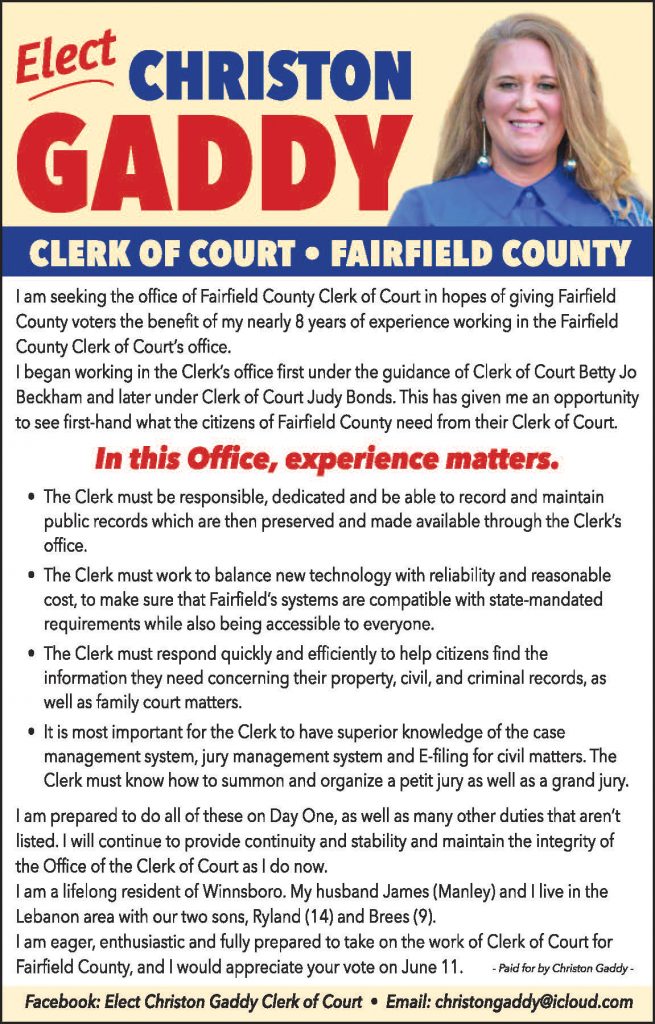After a power outage plunged their meeting room into semi-darkness, the Fairfield County School Board of Trustees cut short its Sept. 20 meeting, excluding an agenda item seeking approval of out-of-state and overnight field trips for students and a review of the August 2016 finance report.
The Board approved the renewal of a contract with the Fairfield County Sheriff’s Office for the School Resource Officer Program that included a five-year extension with changes to provide for two officers at Fairfield Central High School, one officer at Fairfield Middle School and an officer to float between Geiger, Kelly Miller and McCrorey-Liston elementary schools, as well as budgetary changes to address overtime.
Board members approved the contract 7-0 even though they did not have the revised document in front of them. Board member Annie McDaniels (District 4) reminded the Board that at a recent conference they were cautioned, “that we should not vote on things unless we have the final document. So if you still want to go ahead and vote on it, maybe we could just have that revised document, maybe Dr. Green could just send it to us as soon as possible. So if there are any issues we can get that addressed as soon as possible.” Board Chairwoman Beth Reid (District 7) agreed to provide the document.
Student Records Policy
The Board also approved 7 – 0 the first reading of a revised student records policy based on recent updates to the federal Family Educational Rights and Privacy Act (FERPA). Dr. Claudia Edwards, Deputy Superintendent of Academics, said parents are sent two kinds of notices at the beginning of each school year – a notice of their child’s rights under FERPA and a notice outlining what ‘directory’ information the school usually releases to the public about students.
The District’s law firm, Childs & Halligan, P.A., recommended to the Board that it revise its student records policy and an accompanying administrative rule defining what should be included or limited as student directory information, including digital images.
The revised policy rule includes the following language recommended in the Childs & Halligan memo: “With the exception of electronic images related to school-sponsored or district-sponsored events, activities and special recognition, the District will treat all video recorded of students through surveillance videos on District property or school buses as student records entitled to confidentiality pursuant to FERPA and other applicable federal and state laws. Accordingly, the District shall release or allow viewing of video only in certain defined situations, consistent with federal and state law.”
This recommendation prompted McDaniel to ask what generated the policy revision. For example, she said, if there was a video tape showing a student fight or altercation, “You could put a situation to rest real quick (by releasing this tape)… to take those tapes and secure them … might cause us some different issues.”
Her concern, McDaniel said, is if the video needed to be used to determine what occurred with a fight, it might cause problems later if the district refused to release the tape. She didn’t understand why a tape of students fighting would be protected in the same manner as a student record.
“The question is what information (about a student) should be part of the public record and what is private,” Green answered. “As FERPA has been expanded we have a responsibility to our students to ensure that we do not release any privileged information.
“If there were a film of something happening on a bus, for example,” Green said, “as a parent, my perspective may be that I don’t want a video of my child released. An argument could be made that FERPA would cover that. The way the attorneys are framing it, is that all of that falls under the context of the student records.”
The revised policy also states that: “The educational records or school records include all materials directly related to a student that a school maintains. Schools will treat each student’s education records as confidential and primarily for local school use.”
The exception to this rule is for directory information, which the District defines to include the student’s name, address and telephone number as well as participation in officially recognized activities and sports, dates of attendance, diploma or certificate and awards received and similar information which may appear in newspaper articles, on television, in radio broadcasts, school displays, etc.
Teacher Housing
Green also gave a brief update about his proposal for the District building teacher housing – a “teacher village” – as a way to retain and attract good teachers. At the Aug. 16 meeting, Board member William Frick (District 6) suggested Green first survey teachers who have left the District to determine whether, if those teachers had had viable housing options, it would have kept them from leaving the District. Frick said a survey of those who left might determine if there’s a demonstrated need for teacher housing and if it would be helpful for teacher retention.
The next week Green followed up with a survey, but to current teachers, not to teachers who have left the District as Frick suggested. The surveys were email generated to individual teachers from the District office.
At the September meeting, Green said he received 202 responses from his survey with 36% saying they currently live in Fairfield County. Sixty-six employees, he said, indicated that if the housing option was available as early as August 2017, they would be interested in moving into that facility.
Green noted that he was interested in pursuing traditional financing options as opposed to a bond issue, although he said the teacher village could be constructed on about 90 acres of land the district currently owns near Fairfield Central High School.
Green also pointed out that four such projects have been funded in North Carolina. One of these projects, in the Hertford County school district, a district which Green said mirrors Fairfield County, was constructed in 2007. Green said there is always a waiting list for those housing units.
“So this is not a far-out concept,” he added.
Board member Paula Hartman (District 2) asked if Green was able to find out whether the district “was able to venture into this,” since the project would be using district property. Green responded, “Absolutely…why shouldn’t we use district property?”
McDaniel then cautioned that “you do need to check that out, Dr. Green.”
Green agreed, stating that he was still in the investigative phase.












